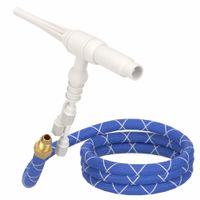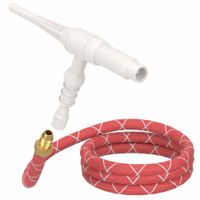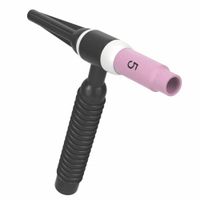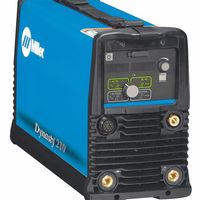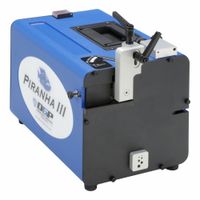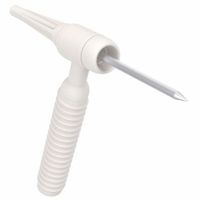Call +(254) 703 030 000 / 751 483 999 / 721 704 777
- Home
- Welding
- Arc Welding
- Tig Welding
.....Read More
Frequently Asked Questions
What is TIG welding used for?
TIG welding, or Tungsten Inert Gas welding, is used for creating high-quality, precise welds on a variety of metals. It is particularly favored for its ability to produce clean, strong, and aesthetically pleasing welds. TIG welding is commonly used in industries where precision is crucial, such as aerospace, automotive, and art and sculpture.
One of the primary applications of TIG welding is in the aerospace industry, where it is used to weld thin sections of stainless steel and non-ferrous metals like aluminum, magnesium, and copper alloys. The process is ideal for these applications because it allows for precise control over the heat input, reducing the risk of warping or distorting the metal.
In the automotive industry, TIG welding is used for both manufacturing and repair. It is often employed to weld components that require a high degree of precision and strength, such as exhaust systems, roll cages, and chassis components. The ability to produce clean welds with minimal spatter makes TIG welding suitable for applications where appearance is important.
TIG welding is also used in the construction of pipelines and pressure vessels, where the integrity of the weld is critical. The process is capable of producing high-quality welds that can withstand high pressures and temperatures, making it ideal for these demanding applications.
Additionally, TIG welding is popular in the art and sculpture world, where it is used to join metals in a way that is both strong and visually appealing. Artists appreciate the control and precision that TIG welding offers, allowing them to create intricate designs and smooth finishes.
Overall, TIG welding is valued for its versatility, precision, and ability to produce high-quality welds across a wide range of applications.
How does TIG welding work?
Tungsten Inert Gas (TIG) welding, also known as Gas Tungsten Arc Welding (GTAW), is a precise welding process that uses a non-consumable tungsten electrode to produce the weld. The process begins by creating an electric arc between the tungsten electrode and the workpiece. This arc generates the heat necessary to melt the metal, forming a weld pool.
An inert gas, typically argon or helium, is used to shield the weld area from atmospheric contamination. This gas flows through the welding torch, enveloping the arc and the molten weld pool, preventing oxidation and other reactions that could weaken the weld.
The tungsten electrode is chosen for its high melting point and excellent conductivity, allowing it to maintain its shape and not melt during the welding process. The welder can control the heat input by adjusting the current, which is crucial for welding thin materials or intricate joints.
Filler metal may be added manually or automatically, depending on the application. The welder feeds the filler rod into the weld pool, where it melts and fuses with the base material, creating a strong joint. In some cases, especially with thin materials, the base metals can be fused without additional filler.
TIG welding is known for producing high-quality, clean welds with excellent aesthetic appearance and minimal spatter. It is widely used in industries requiring precision, such as aerospace, automotive, and art. The process is versatile, capable of welding a wide range of metals, including stainless steel, aluminum, and magnesium.
However, TIG welding requires a high level of skill and is generally slower than other welding methods, making it less suitable for high-volume production.
What materials can be welded with TIG welding?
TIG welding, or Tungsten Inert Gas welding, is a versatile welding process that can be used to weld a wide range of materials. The primary materials that can be welded using TIG welding include:
1. **Stainless Steel**: TIG welding is highly effective for stainless steel, providing clean and precise welds. It is commonly used in industries where corrosion resistance and aesthetic appearance are important.
2. **Aluminum**: Due to its excellent control over heat input, TIG welding is ideal for aluminum, which requires careful handling to prevent warping and cracking. It is widely used in the automotive and aerospace industries.
3. **Carbon Steel**: TIG welding can be used for carbon steel, offering strong and durable welds. It is suitable for both thin and thick sections, making it versatile for various applications.
4. **Magnesium**: TIG welding is suitable for magnesium and its alloys, often used in the aerospace and automotive industries due to their lightweight properties.
5. **Copper and Copper Alloys**: TIG welding can effectively weld copper and its alloys, such as bronze and brass, which are used in electrical and plumbing applications.
6. **Nickel and Nickel Alloys**: These materials are often used in high-temperature and corrosive environments, and TIG welding provides the necessary precision and control.
7. **Titanium**: Known for its strength and corrosion resistance, titanium is commonly used in aerospace and medical applications. TIG welding is preferred for its ability to produce high-quality welds without contamination.
8. **Exotic Alloys**: TIG welding is also suitable for welding exotic and specialized alloys used in various high-performance applications.
TIG welding is favored for its precision, control, and ability to produce high-quality welds across a diverse range of materials, making it a preferred choice in industries requiring high standards of weld integrity.
What are the advantages of TIG welding?
TIG welding, or Tungsten Inert Gas welding, offers several advantages:
1. **Precision and Control**: TIG welding provides superior control over the welding process, allowing for precise welds. This is particularly beneficial for intricate designs and thin materials.
2. **High-Quality Welds**: The process produces clean, high-quality welds with minimal spatter and no slag, reducing the need for post-weld cleanup.
3. **Versatility**: TIG welding is versatile and can be used on a wide range of metals, including stainless steel, aluminum, magnesium, and copper alloys. It is suitable for both thin and thick materials.
4. **Strong, Durable Joints**: The welds created are strong and durable, making them ideal for critical applications in industries such as aerospace and automotive.
5. **No Filler Material Required**: TIG welding can be performed without filler material, which is advantageous for applications requiring a clean, precise weld.
6. **Low Distortion**: The process allows for better control of heat input, reducing the risk of distortion in the welded materials.
7. **Aesthetic Finish**: TIG welding produces aesthetically pleasing welds, which is important for applications where appearance is crucial.
8. **Environmentally Friendly**: The process uses inert gas, which is non-reactive and does not produce harmful emissions, making it environmentally friendly.
9. **All-Position Welding**: TIG welding can be performed in all positions (flat, horizontal, vertical, and overhead), providing flexibility in various welding scenarios.
10. **Minimal Sparks and Fumes**: The process generates fewer sparks and fumes compared to other welding methods, contributing to a safer working environment.
These advantages make TIG welding a preferred choice for applications requiring precision, strength, and high-quality welds.
What is the difference between TIG and MIG welding?
TIG (Tungsten Inert Gas) and MIG (Metal Inert Gas) welding are both arc welding processes that use an electric arc to join metals, but they differ in several key aspects:
1. **Electrode**:
- TIG welding uses a non-consumable tungsten electrode. The tungsten electrode does not melt; instead, a separate filler material is used if needed.
- MIG welding uses a consumable wire electrode that melts and becomes part of the weld.
2. **Shielding Gas**:
- TIG welding typically uses inert gases like argon or helium to protect the weld area from atmospheric contamination.
- MIG welding also uses inert gases, often a mix of argon and CO2, to shield the weld.
3. **Control and Precision**:
- TIG welding offers greater control and precision, making it suitable for thin materials and intricate welds. It requires more skill and is generally slower.
- MIG welding is faster and easier to learn, making it suitable for thicker materials and high-production environments.
4. **Applications**:
- TIG welding is ideal for welding thin sections of stainless steel, aluminum, and other non-ferrous metals. It is often used in aerospace, automotive, and art applications.
- MIG welding is commonly used in industrial and construction settings for welding thicker materials like steel and aluminum.
5. **Quality and Appearance**:
- TIG welding produces high-quality, clean welds with a superior finish, often requiring little to no post-weld cleanup.
- MIG welding can produce strong welds but may require more cleanup due to spatter.
6. **Equipment Complexity**:
- TIG welding equipment is generally more complex and expensive, with foot pedals and hand controls for precise adjustments.
- MIG welding equipment is simpler and more cost-effective, with automatic wire feeding.
In summary, TIG welding is preferred for precision and quality, while MIG welding is favored for speed and ease of use.
What type of gas is used in TIG welding?
Tungsten Inert Gas (TIG) welding, also known as Gas Tungsten Arc Welding (GTAW), primarily uses argon as the shielding gas. Argon is an inert gas, meaning it does not react with the weld pool or the tungsten electrode, providing a stable and controlled environment for the welding process. This prevents oxidation and contamination of the weld area, ensuring high-quality welds.
In some cases, helium is used either alone or mixed with argon. Helium provides a hotter arc, which can be beneficial for welding thicker materials or metals with high thermal conductivity, such as aluminum and copper. The choice between argon and helium, or a mixture of both, depends on the specific requirements of the welding task, including the type of material, thickness, and desired weld characteristics.
For specialized applications, other gas mixtures may be used, such as argon mixed with small amounts of hydrogen or nitrogen, to enhance certain properties of the weld. However, argon remains the most commonly used gas in TIG welding due to its versatility, availability, and cost-effectiveness.
How do you set up a TIG welder?
1. **Safety First**: Wear appropriate safety gear, including gloves, a welding helmet with the correct shade, and protective clothing.
2. **Select the Right Equipment**: Choose a TIG welder suitable for your project. Ensure you have a tungsten electrode, filler rod, and shielding gas (usually argon).
3. **Prepare the Work Area**: Ensure the work area is clean and free of flammable materials. Set up a stable workbench and secure the workpiece.
4. **Connect the TIG Torch**: Attach the TIG torch to the welder. Connect the power cable, gas hose, and control cable if applicable.
5. **Install the Tungsten Electrode**: Grind the tungsten electrode to a point for DC welding or a rounded tip for AC welding. Insert it into the collet and tighten the collet body.
6. **Set Up the Ground Clamp**: Attach the ground clamp to the workpiece or workbench to complete the electrical circuit.
7. **Connect the Gas Cylinder**: Secure the argon gas cylinder and connect the regulator. Open the cylinder valve and adjust the flow rate to about 15-20 cubic feet per hour (CFH).
8. **Adjust the Welder Settings**: Set the welder to the appropriate current type (AC for aluminum, DC for steel). Adjust the amperage based on material thickness and electrode size.
9. **Select the Filler Rod**: Choose a filler rod compatible with the base material. Ensure it is clean and free of contaminants.
10. **Test the Setup**: Perform a test weld on a scrap piece of metal to ensure settings are correct and the arc is stable.
11. **Begin Welding**: Position the torch at a 15-20 degree angle, start the arc, and begin welding, feeding the filler rod as needed. Adjust speed and technique for optimal results.

